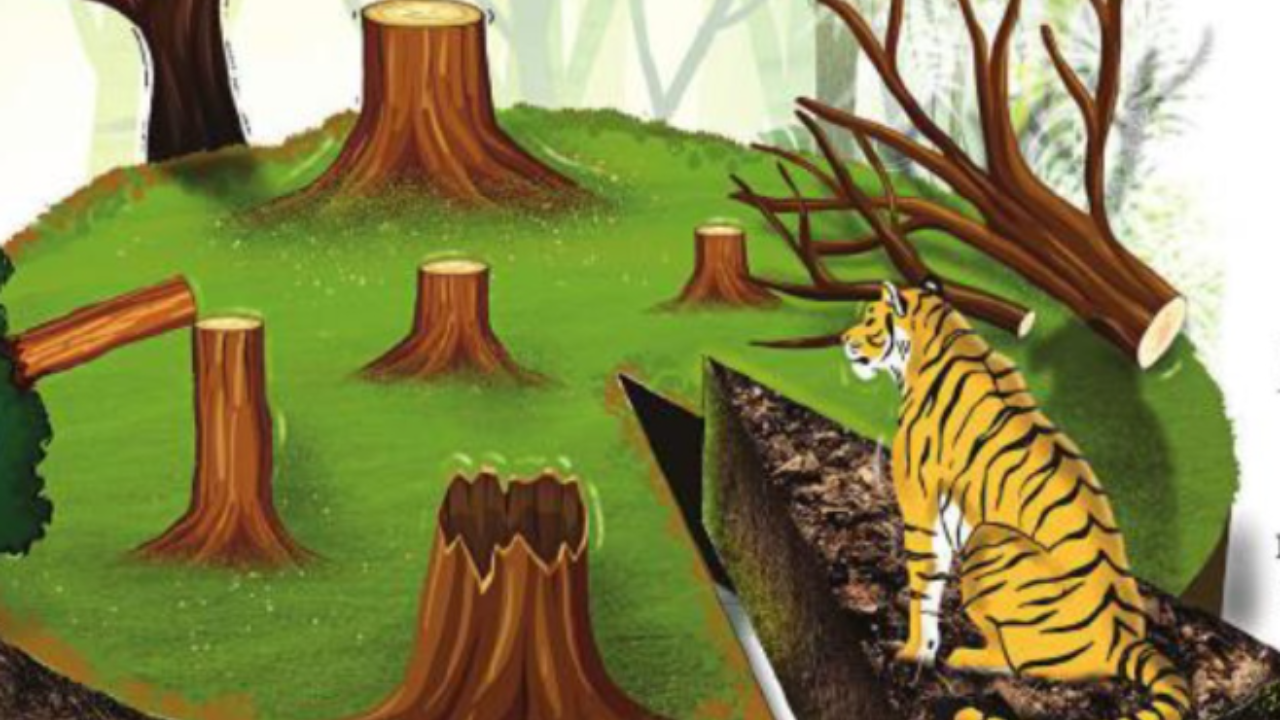These ‘forests’ are disturbing balance | India News – Times of India

You save forests, you save the tiger. This was one of the driving forces behind Project Tiger, which completed half a century on April 1.
But as irony would have it, one of the key extensions of forest departments across India — forest development corporations (FDCs) — may be causing more damage to the tiger ecosystem rather than preserving it. Some experts have even gone to the extent of calling these corporations incorporated under the Companies Act as ‘forest destruction corporations’.
Questions are being asked about FDCs’ initiatives, especially of resorting to the monoculture of a few species, like teak and eucalyptus, for financial exploitation.
Not only are these strategies harmful to tiger conservation, but also playno role in climate change.
Maharashtra has leased out 3. 43 lakh hectares (6%) of the total forest area to the Forest Development Corporation of Maharashtra (FDCM).
FDCM commercially extracts about 50,000 cubic metres of timber annually, causing substantial environmental damage, experts feel. In addition, it takes high-quality miscellaneous forests, which act as food security and habitat for tigers, and removes these for teak plantations.
Wildlife conservationist Prafulla Bhamburkar says, “FDCM’s monoculture plantations are now outdated. Old, dense mixed forests are more important to maintain biodiversity and ecological balance. ”
In 2015, a study by Nature magazine found that 45% of government pledges to reforestation were all monoculture plantations of fast-growing trees like acacia and eucalyptus. The researchers felt that in the long run, such initiatives would hurt biodiversity.
Former honorary wildlife warden Uday Patel says, “Miscellaneous forests provide maximum food availability for wildlife in fruits, leaves and grass, and shrubby canopy throughout the year. Therefore, it has the highest capacity to hold herbivore populations and carnivores. This also limits crop raiding by wild animals. ”
According to Patel, deadly monoculture plantations act as ‘green deserts’ that have the least capability of mitigating climate change. “The FDCs’ experience of growing trees should be used to increase forests on wastelands,” he says.
Kerala Forest Development Corporation (KFDC) has a slightly different story to tell. KFDC, which went for pulpwood plantations, had to discontinue it after Forest Conservation Act, 1980. Former KFDC officials recall how the institution had to diversify its activities. KFDC embarked on community-based ecotourism and earned revenue through pulpwood and teak.
Climate change is adversely affecting the productivity of cardamom (which is a very climate-sensitive crop), says CA Abdul Basheer, retired divisional manager of KFDC. “Carefully planned ecotourism and imparting proper training to the dependent community, is the only way to go forward,” says Basheer.
For environmentalist R Sridhar, it is imperative to consider ecological needs while initiating conservation projects. “Kerala needs timber. We have to look at things more sustainably. For example, riverine vegetation must be promoted near the waterbodies, and trees must be replaced,” says Sridhar.
Despite the plans to diversify in Telangana, eucalyptus still dominates most of the plantations.
Out of 33,000 hectares of forests leased out to Telangana State Forest Development Corporation, eucalyptus is spread over 22,000 hectares, bamboo 8,000 hectares, teak 200 hectares and red sanders, sandalwood and others in 600 hectares. Monoculture has depleted the soil health in eucalyptus plantations.
TSFDC senior divisional manager and assistant director (ecotourism) G Skylab says, “We cut the eucalyptus plantation every six years on a rotation basis. We harvest 2 lakh tonnes of eucalyptus worth ₹100 crore annually and ₹10 crore worth of bamboo. To overcome the problems of monoculture, we are going for other plantations like red sanders and sandalwood. ”
“We are also into ecotourism, including botanical gardens in Hyderabad, resorts in backwaters and national parks,” says Skylab.
But as irony would have it, one of the key extensions of forest departments across India — forest development corporations (FDCs) — may be causing more damage to the tiger ecosystem rather than preserving it. Some experts have even gone to the extent of calling these corporations incorporated under the Companies Act as ‘forest destruction corporations’.
Questions are being asked about FDCs’ initiatives, especially of resorting to the monoculture of a few species, like teak and eucalyptus, for financial exploitation.
Not only are these strategies harmful to tiger conservation, but also playno role in climate change.
Maharashtra has leased out 3. 43 lakh hectares (6%) of the total forest area to the Forest Development Corporation of Maharashtra (FDCM).
FDCM commercially extracts about 50,000 cubic metres of timber annually, causing substantial environmental damage, experts feel. In addition, it takes high-quality miscellaneous forests, which act as food security and habitat for tigers, and removes these for teak plantations.
Wildlife conservationist Prafulla Bhamburkar says, “FDCM’s monoculture plantations are now outdated. Old, dense mixed forests are more important to maintain biodiversity and ecological balance. ”
In 2015, a study by Nature magazine found that 45% of government pledges to reforestation were all monoculture plantations of fast-growing trees like acacia and eucalyptus. The researchers felt that in the long run, such initiatives would hurt biodiversity.
Former honorary wildlife warden Uday Patel says, “Miscellaneous forests provide maximum food availability for wildlife in fruits, leaves and grass, and shrubby canopy throughout the year. Therefore, it has the highest capacity to hold herbivore populations and carnivores. This also limits crop raiding by wild animals. ”
According to Patel, deadly monoculture plantations act as ‘green deserts’ that have the least capability of mitigating climate change. “The FDCs’ experience of growing trees should be used to increase forests on wastelands,” he says.
Kerala Forest Development Corporation (KFDC) has a slightly different story to tell. KFDC, which went for pulpwood plantations, had to discontinue it after Forest Conservation Act, 1980. Former KFDC officials recall how the institution had to diversify its activities. KFDC embarked on community-based ecotourism and earned revenue through pulpwood and teak.
Climate change is adversely affecting the productivity of cardamom (which is a very climate-sensitive crop), says CA Abdul Basheer, retired divisional manager of KFDC. “Carefully planned ecotourism and imparting proper training to the dependent community, is the only way to go forward,” says Basheer.
For environmentalist R Sridhar, it is imperative to consider ecological needs while initiating conservation projects. “Kerala needs timber. We have to look at things more sustainably. For example, riverine vegetation must be promoted near the waterbodies, and trees must be replaced,” says Sridhar.
Despite the plans to diversify in Telangana, eucalyptus still dominates most of the plantations.
Out of 33,000 hectares of forests leased out to Telangana State Forest Development Corporation, eucalyptus is spread over 22,000 hectares, bamboo 8,000 hectares, teak 200 hectares and red sanders, sandalwood and others in 600 hectares. Monoculture has depleted the soil health in eucalyptus plantations.
TSFDC senior divisional manager and assistant director (ecotourism) G Skylab says, “We cut the eucalyptus plantation every six years on a rotation basis. We harvest 2 lakh tonnes of eucalyptus worth ₹100 crore annually and ₹10 crore worth of bamboo. To overcome the problems of monoculture, we are going for other plantations like red sanders and sandalwood. ”
“We are also into ecotourism, including botanical gardens in Hyderabad, resorts in backwaters and national parks,” says Skylab.







